How to properly install the stove in the country?
Attention: the installation and the first heating of the furnace are carried out only with the participation of a specialist from the manufacturer or supplier!
The stove can be installed on a foundation or directly on the floor. When installing the stove, a platform with a thickness of at least ¼ of a brick is laid out on a wooden floor; its size must be such that the distance from the oven to the edges is at least 250 mm. A cement screed or metal sheet is laid on top of the brick. It is obligatory to have a metal sheet under the fire door. It is strictly forbidden to install fences around the stove that impede air exchange.
Distance to combustible materials:
- From the back and sides of the oven: not less than 500 mm
- Door side: 1250 mm
- Top: 1200 mm.
The distance along one of the sides can be reduced, provided that the combustible material is protected by a brickwork of ½ brick thickness with a gap of at least 30 cm from the combustible surface. In this case, the distance from the other side of the oven to combustible materials should be 1 m or more. It is impermissible to reduce the safety distances at the rear, top and front of the oven!
Chimney. It is recommended to use thermally insulated sandwich modules in combination with single-wall pipes. The inner pipes of the sandwich are connected by inserting the upper element into the lower one, the outer ones - vice versa: the upper segment is pushed onto the lower one. Remember: sandwich modules are by no means installed in the base of the chimney, where it comes into contact with the stove, in this place a single-wall pipe is mounted.
In places where the chimney passes through the ceilings, a steel ceiling cut must be installed. The groove thickness should be 70 mm greater than the overlap thickness. Gaps between grooves and floor structures are insulated with stone wool, expanded clay or other non-combustible materials. A special roof pass-through unit is mounted in the roof. When bringing the chimney to a roof made of combustible materials, it is necessary to install a spark arrester on the pipe.
The chimney height from the grate is at least 5 m.
The distance to flammable structures from the inner surface of the pipe is at least 500 mm. It is allowed to reduce the distance to 380 mm, provided that the combustible structures are protected with a metal sheet over asbestos cardboard (8 mm) or plaster (25 mm) over a metal mesh.
The height of the chimney depends on its location and roof configuration.
- At a distance of less than 1.5 m from the ridge or parapet - at least 500 mm from the top of the ridge or parapet.
- At a distance of 1.5 - 3 m from the ridge or parapet - not lower than the ridge or parapet.
- At a distance of more than 3 m from the ridge or parapet - not lower than a line drawn down from the ridge at an angle of 10 ° to the horizon.
- Above a flat roof - 500 mm.
Let's admit the outlet of the chimney not through the roof, but through a wall made of non-combustible materials, subject to all installation rules. In this case, for the normal removal of combustion products, the chimney must be installed at an angle of at least 45 ° in the ascending direction; the horizontal arrangement of the chimney is unacceptable.
Heating of the second floor is possible by using heat from the chimney. For this, sandwich modules are installed only in the places where they pass through the ceilings, and a single-wall pipe is mounted in a heated room.

Stove-stove in a country house
How to make Loginov's stove with your own hands?
The manufacture of Loginov's stove does not require special tools or materials. The master must be able to cook, cut and rivet metal, adhere to the scheme exactly.
Instruments
When working with metal, you will need the following tools:
- Grinder for cutting metal.
- Welding machine, accompanying protective equipment.
- Gun for riveting metal.
- Tool for cutting threads of different diameters.
- Drill and drill bit for metal.
Materials (edit)
Materials for making Loginov's potbelly stove:
- Metal sheets with a thickness of at least 3mm, with a total area of 1.35m2.
- Iron bars 45 cm long - 6 pcs.
- Chimney pipe 100mm. The length depends on the height of the room.
- Pipe 80mm and 30mm for blowing and venting.
- A 200mm pipe, about 10 cm long, for the firebox door.
- Plug 220mm.
- The metal corner for the legs is about 1.2 meters, depending on the planned height of the structure.
- Rivets 6pcs
Step-by-step instruction
-
Cut the metal into the desired pieces in the form of a rectangle according to the scheme (above, in p. Scheme and drawing).
Prepare leafy chunks
- Cut openings in the pipes and metal sheet for the front part of the stove for the furnace door and blower, and also make a hole for the chimney pipe in the top sheet.
-
Cut threads at the ends of the pipes 200mm and 30mm, inside the firebox door and the blower plug.
Make pipe threads
- In a 30mm pipe in the thread area, drill holes in a circle in a staggered manner. There should be no holes outside the thread.
-
Weld a blower from 80mm and 30mm pipes according to the scheme, weld the pipe edge by 80mm. Make a cap for the blower.
Also, the blower can be upgraded as in this photo.
-
Weld the sheets of metal together, weld the chimney outlet, the fuel door and the blower to the holes.
Weld the body
Weld the rest of the parts to this body.
- Weld iron rods onto the walls of the furnace.
- Put the stove on its feet by welding a metal corner. Cut and bend the legs of the corner as in the diagram.
- Weld the screen. Using a special pistol, rivet the sheets together as in the drawing, bending the sheet of metal on the back of the screen.
-
Weld up the chimney pipe at the smoke outlet.
Weld the chimney
- Check for defects, assemble and lead the chimney outside.
- Carry out a test furnace. If the stove does not smoke, has good draft, then the work is over. The oven is now ready for use.
Types of stoves
The furnace body can be made of several types of metal:
- become;
- cast iron.
When the stove is made of cast iron and heated with wood, we can talk about a very large weight. To warm up such a mass, it takes time much longer than the heating of the steel structure.
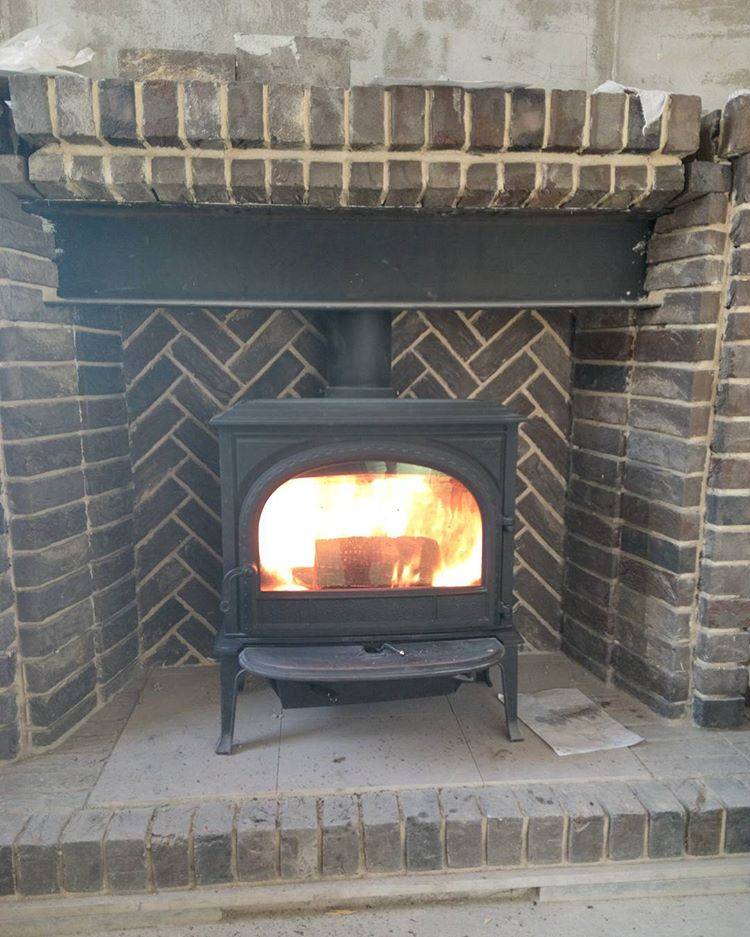
However, this inertness quickly becomes a positive quality as the oven begins to cool down. Steel walls remain hot only when there is a combustion process. As soon as it stops, they instantly cool down.
Cast iron cannot cool down so quickly, it will give off heat for a long time after the cessation of combustion and complete attenuation.
The service life of a cast-iron stove is much longer than its metal counterpart. The walls burn out very slowly. Unfortunately, there is one major drawback. If the stove is hit with a heavy object, it may crack and become unusable.
There are several types of stove-stove models:
- without legs;
- with legs;
- rectangular;
- barrel-shaped.
The most suitable fuel for such a structure, according to its manufacturers, is rectangular firewood. There are many more of them in the firebox.
When the "potbelly stove" is made by hand, it is most often given a barrel-shaped shape.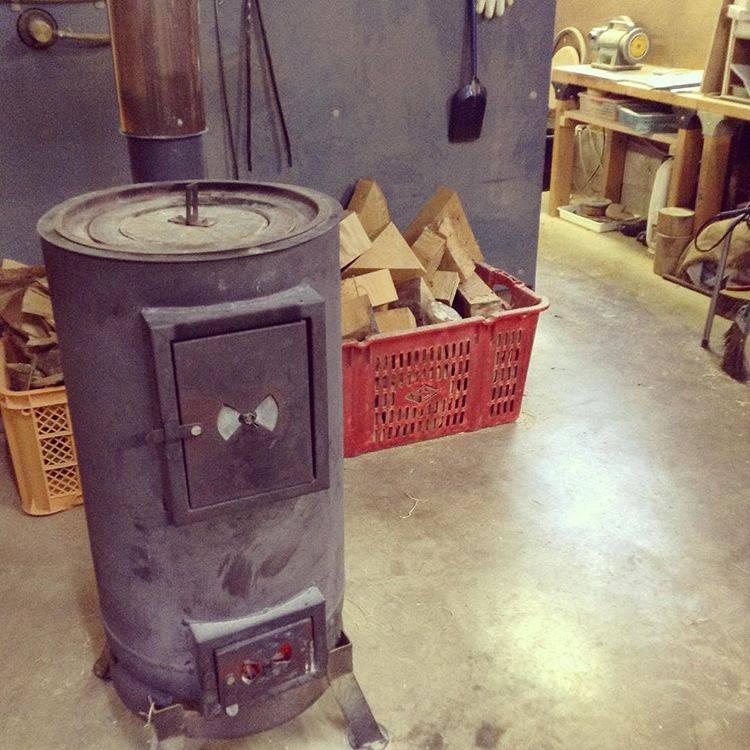
Safety recommendations

dry firewood and logs
What must be observed for the safe operation of the stove:
- The installation of the stove must be done on a non-combustible base;
- All objects and flammable surfaces should be no closer than 70-80 cm from the stove;
- Do not put more than three kilograms of fuel into the stove at a time;
- The firebox door must always be closed, excluding the moment of loading firewood;
- It is forbidden to operate the stove in case of malfunctions with the chimney;
- Do not leave a working oven unattended for a long time or with small children;
- It is forbidden to touch the furnace body while it is operating or immediately after the flame is extinguished in it, the entire surface heats up to a very high temperature;
- Do not leave or keep flammable objects and materials near the working stove.
Subject to all the rules, the potbelly stove will heat the room for a long time.
Installation of a stove
It should be remembered that the installation and operation of a potbelly stove, as a temporary heating device, is almost always a struggle for the presence of traction in the stove's firebox. When installing the stove, one must not abuse the length, as well as the number of bends and bends of the chimney, since each of them increases the resistance to the gas flow, and, accordingly, reduces the draft. But it is still desirable to have a horizontally located chimney section leading from the stove to the exit from the room, the so-called hog. Since the hog significantly (up to 25%) increases the heat transfer and, accordingly, the economy of the potbelly stove. The hog can be quite hot, and therefore it must be equipped with a higher than average height of the people in the room. The exit of the stove chimney from the room is equipped, as a rule, through a window (in light structures such as a hut, a tent - and through the ceiling), using cutting - a metal sheet with a hole for the chimney, which isolates the hot chimney pipe from the wooden frame of the window and the tent awning.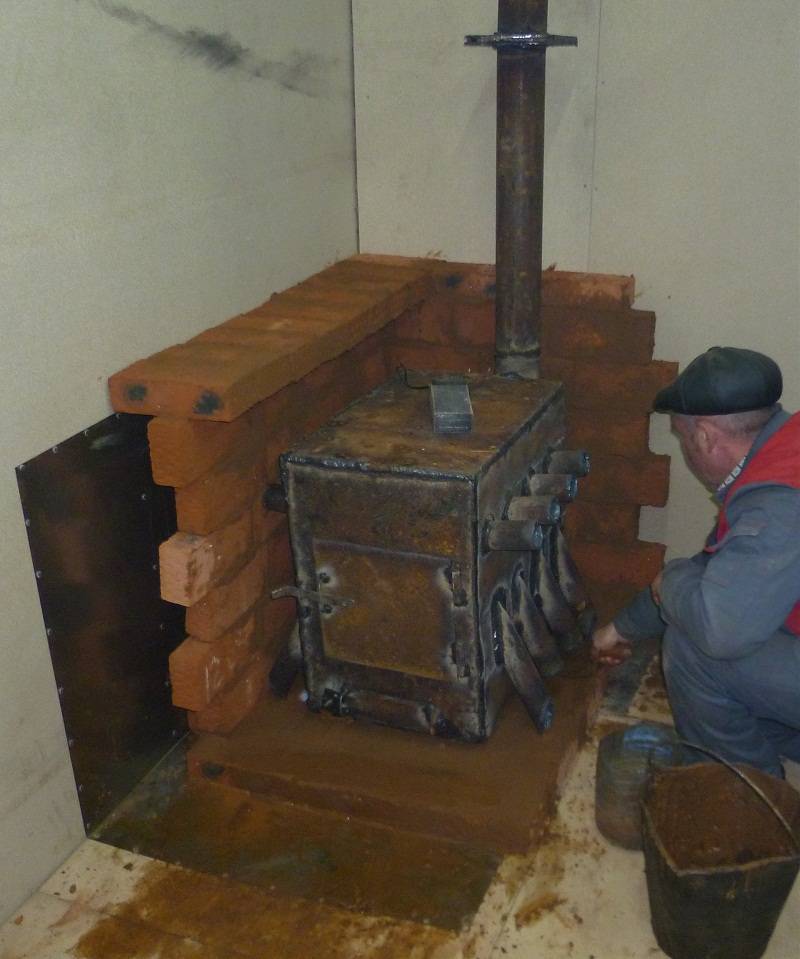
Installing the stove
Installation rules are based on protecting the surrounding objects and walls from the hot walls of the stove:
- Base. It must be non-flammable. Ideal, of course, is a concrete slab, but few people can afford such a high-quality foundation in the country. A plot of ceramic tiles, a brick base is suitable. Models with legs are not so demanding on the base, since the legs, although they heat up, but to a lesser extent. Here you can apply a sheet of tin.
- Distance to walls. If the walls are wooden or sheathed with flammable materials, the distance to them should be at least 70 cm, if the plastic is even more. The same principle applies to furniture.
- Chimney. Pipe diameter from 85 to 150 mm. If possible, you should avoid joining the pipe, especially in a residential area, but if you have to connect, then the joint should be completely sealed. The joints should not coincide with the place where the pipe passes through the ceilings and the roof. In these areas, a non-combustible barrier is made of brick, ceramics or concrete, which will protect the floor materials from fire. Often the potbelly stove pipe is taken out the window, and the stove itself is placed in the middle of the room. In this case, the section of the pipe extending from the furnace (horizontal or inclined) will act as an afterburner and give off heat to the room.
- Ventilation. The potbelly stove burns with an open principle. This means that it will take the necessary oxygen from the room in which it is located. Therefore, according to the standards, it needs to provide a sufficient amount of fresh air: for 1 kW - 10 m3 per hour. Few country houses can boast of good supply and exhaust ventilation, so the problem is usually solved by ventilation. Otherwise, people will experience unpleasant symptoms of oxygen deprivation.
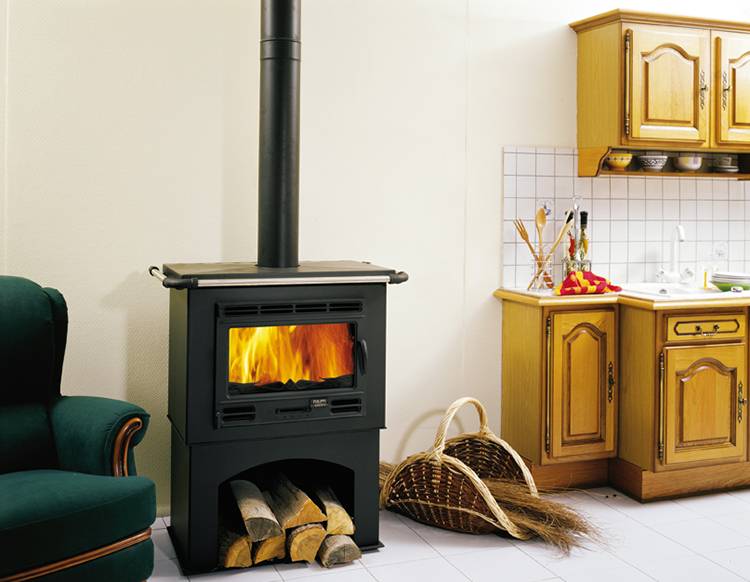
Stove after installation
To make the potbelly stove mobile, that is, to be able to rearrange it from place to place, part of the chimney can be made of fireproof corrugation. You just have to pay more attention to cleaning, because the corrugated section will become a place for the accumulation of soot.
How does a stove-stove work?
The firebox consists of a combustion chamber, where firewood is burned, and a chamber for the ash pan, separated from the combustion chamber by a grate. In the upper part of the furnace there is a gas duct and an opening for connecting a chimney.
The ash pan drawer is designed to collect ash, which is poured into it from the firebox. In modern models of furnaces, the ash pan door is equipped with a seal and plays the role of a combustion mode regulator.
The oven door is a box with a heat-resistant glass window, a seal and a latch. The simplest models may not have a window.
The chimney consists of single-walled or double-walled steel pipes (the so-called sandwich). In the space between the pipes of the sandwich chimney there is a heat-insulating material (for example, expanded vermiculite). This technology increases the fire safety of the chimney by lowering the temperature at the points of contact with the structures of the house.The inner tube of the sandwich modules is made of high-alloy stainless steel, the outer tube is made of mirror stainless steel or galvanized. The chimney is equipped with a special rotary damper - a damper for manual draft adjustment.
The furnace body is assembled from heat-resistant steel and covered with heat-resistant organosilicon enamel or other decorative materials that can withstand high temperatures. Modern models of stoves can have a special convector casing: cold air, entering it from below, heats up against the walls of the stove and comes out from above through special holes. This simple technology can significantly improve the efficiency of the furnace.
Optional equipment. A hob for cooking can be mounted on the top cover of the oven. There are models with a built-in electric heat gun, as well as with the possibility of installing heat collectors to supply warm air to adjacent rooms.
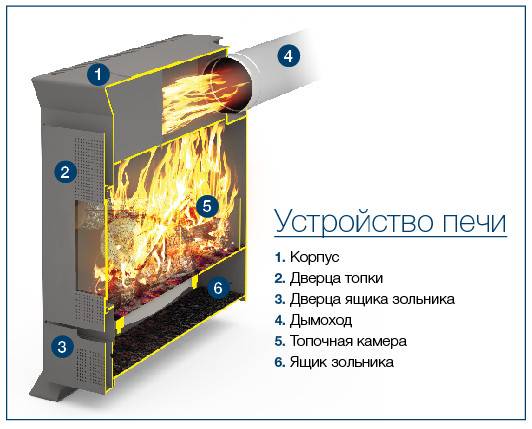
Furnace for giving (potbelly stove): device
Main functions
Today, such models have a variety of styles. By installing them for heating, they also play the role of decorating the room.
The fuel for such a system is firewood, the length of which does not exceed 25 cm. You can also use other solid fuels. The main purpose of the potbelly stove:
- heating the building;
- cooking food;
- interior detail or decorative decoration.
"Burzhuyka" successfully competes with brick and fireplace systems. However, it has one very important advantage, its dimensions are not large. This stove is easy to transport and connect. It is often used outdoors for picnic cooking.
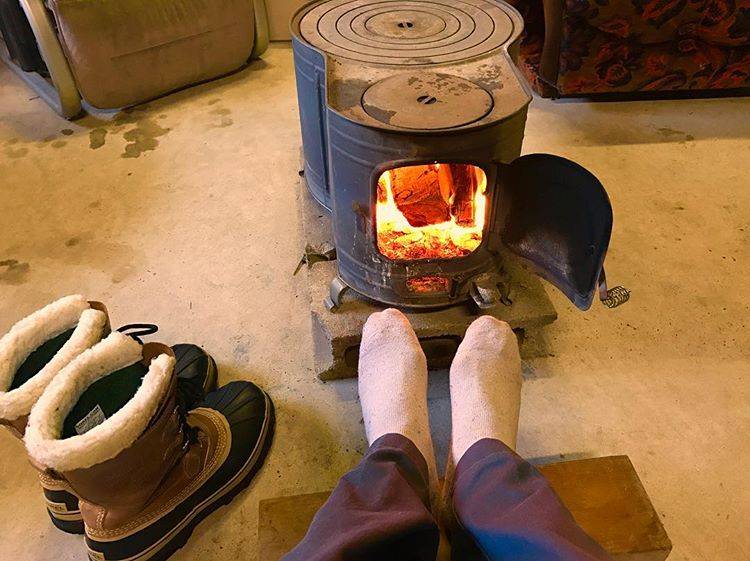
When you constantly have to transport the stove to different places, a collapsible design may be the best solution. In it, the top cover is removed, which plays the role of a hob. The legs are very easy to disassemble, and the chimney is removed. If desired, you can divide the entire stove into several separate sections.
As a result, the stove does not need a lot of space to store it, it becomes mobile and easily transported.
Using such a heating device, you do not have to worry about the ingress of carbon monoxide into the upper respiratory tract. All harmful gas is removed through the chimney
Correct installation is essential to achieve this effect. Stove power will reach its maximum if you create good traction

User manual
The most important prerequisite for operation is good welding quality. Use chalk and kerosene to check for fistulas and defects. To treat the seams of the chimney especially scrupulously. Load the wood into the combustion chamber, light the fire, close the door and regulate the process with a blower. To reduce the intensity of combustion, you need to screw on the blower; to put out the fire, it is enough to turn it completely.
Heat radiating from metal at a temperature higher than from brick or stone
Always use a thick potholder to adjust the blower, do it carefully and quickly. Clean the oven after cooling completely
In the presence of welding defects, operation is stopped and the defects are corrected. Carbon monoxide can be fatal.
According to some reviews, this stove can smoke when the firebox door is opened. This is due to a decrease in thrust. The defect can be eliminated by increasing the diameter of the chimney pipe to 150 mm and reducing its length.
Slow-burning stoves are popular with fishermen and tourists. Replacing a thick sheet of metal with light and thin stainless chimney pipes, they successfully use Loginov's scheme for winter fishing and tourism
For such furnaces, welding is rarely used.
Solid fuel heating furnaces
The product "Cast iron stove BLMZ PCh-2" has been added to the cart.
The item “Vesuvius Triumph 180 cast iron stove” has been added to the cart.
The item "Vesuvius AOGT (metal door) long burning oven" has been added to the cart.
The item “Sibir BV long burning stove” has been added to the cart.
The product "POV-57 army potbelly stove" has been added to the cart.
The item “Vesuvius Mini stove-potbelly stove” has been added to the cart.
The item “Vesuvius B5 stove-potbelly stove” has been added to the cart.
Product “Heating stove COMFORT 100” has been added to the cart.
The product “Steel stove stove“ Stolypinka ”” has been added to the cart.
The product “Long-burning gas generating furnace Vesuvius AOGT (cooking surface)” has been added to the cart.
The product “Heating stove Dacha” has been added to the cart.
Product “Heating stove Alaska 150” has been added to the cart.
Product “Heating stove Alaska 150M” has been added to the cart.
Product “Heating stove Vesuvius B8” has been added to the cart.
The item “Heating furnace Vesuvius B10” has been added to the cart.
The product "Combat Heating and Cooking Stove" has been added to the cart.
Product “Heating and cooking stove GrayVary 1.100” has been added to the cart.
Product “Heating stove COMFORT 150” has been added to the cart.
The product “Zlata oven” has been added to the cart.
The product “Sister-Stove” has been added to the cart.
Product “Oven Matryoshka small 1 burner” has been added to the cart.
Product “Oven Matryoshka small 2 burners” has been added to the cart.
Product “Oven Matryoshka large 1 burner” has been added to the cart.
Product “Oven Matryoshka large 2 burners” has been added to the cart.
Product “Heating stove Varna” has been added to the cart.
Product “Heating stove Stavr” has been added to the cart.
The product "Cast iron shashlik oven PChM-2" has been added to the cart.
Convenient and practical potbelly stoves help to solve the problem of heating summer cottages and temporary houses on the plots. In our climate, even in the warm season, it can be very cold. It offers a convenient way to solve this problem - heating stoves of potbelly stoves. Summer residents highly appreciated their quality, convenience and attractive design. Stove stoves can be used as a heat source and even cook food on it.
The stove-stove is capable of giving not only warmth, but also extraordinary comfort. Even the coldest evening will become romantic and pleasant thanks to the cheerful crackle of a live fire.
Advantages
An ordinary wood-burning stove-potbelly stove quite copes with heating a room up to 40 square meters, even in severe frosts.
Environmental friendliness
The stove uses the most natural fuel - wood or coal.
Free and affordable fuel
Fuel for a wood-burning stove can be found in any nearby copse, and on the site after the annual pruning of garden trees, there is enough firewood to heat the dacha.
The oven is suitable for both heating and cooking
The potbelly stove will not only heat the house, but also allow you to cook a delicious lunch on it.
Potbelly stove creates a special atmosphere
The stove creates a magical and peaceful mood. Ever since primitive times, the sound of peacefully crackling firewood in the fire soothed the first people who were tired and frozen after a successful hunt.
Heats up quickly
Due to the metal walls, it warms up in just a few minutes.
A heating stove for a dacha potbelly stove is intended for heating small rooms: country houses, summer cottages, temporary huts, trailers. It will provide heating of air in rooms with a volume of up to 100 cubic meters. "Stove stove" is a heating device that does not require a large amount of fuel, but is capable of high-quality heating of the room. Stove stoves also have a wide upper platform where you can cook food.
Register and save your shopping cart.
Even if you need to interrupt purchases and leave the site, you
you can return to your saved basket at any time.
Operation of a potbelly stove
The use of a potbelly stove involves the alternation of its kindling cycles, which include:
- fuel loading;
- ignition of the loaded fuel in the stove;
- the firebox of the stove (its useful use for the purpose of heating people and premises);
- ash cleaning from the blower and combustion chamber.
The most important is the stage of loading the fuel, which must be stored in a manner that makes it easier to ignite. First, paper and thin dry branches are stacked, on top of them are larger dry chopped logs. Coal is loaded, as a rule, on top of already well-burnt firewood.
To restore traction, it will often be necessary to disassemble the chimney and clean its pipes and elbows from accumulated soot. Also, the regulation of the draft in the stove must be done by a gate damper, or by changing the length and position of the chimney pipes.
Thus, working on solid fuel, which can be found almost everywhere, a hand-made mobile metal stove potbelly stove will become a reliable help to a zealous owner in very many difficult life situations.
Simple designs of stove stoves
There are several options for stove stoves, each of which has a set of both positive and negative properties.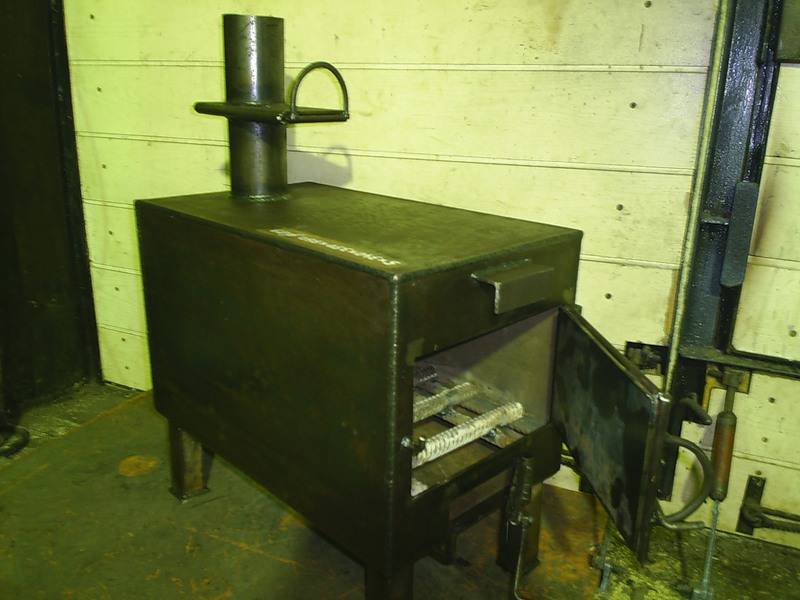
Potbelly stove from a gasoline barrel
As already noted, this version of a homemade metal stove is fragile, but captivates with its cheapness and ease of manufacture.
As a rule, it provides for placing the barrel in a horizontal position, but it is possible to equip a potbelly stove in the form of a vertically located metal barrel.
In the front wall of the barrel, rectangular windows of the firebox and blower are carefully cut out with a grinder, doors are made from the cut parts (awnings, a handle, a lock - latch, dimensional stripes around the perimeter are welded on), which are hung on the corresponding windows of the front wall of the barrel. The blower window need not be cut; instead, at the very bottom of the front wall, it is enough to drill a number of air inlet holes with a diameter of about 20 mm. In the back of the upper wall of the barrel, neatly, from the center marked with a core or punch, several radial cuts are made to the size of the future chimney opening. After that, the formed metal petals are bent upward, simultaneously forming a chimney hole and the likeness of its branch pipe.
Potbelly stove for giving from a gas cylinder
As a rule, it is equipped with a horizontally located cylinder, the thick-walled metal body of which forms the combustion chamber of the future stove. The end part of the cylinder with a tap is neatly cut off by a grinder, and a firebox door is made from it (awnings, a handle, a lock - a latch are welded), which is hung back on the cylinder - a firebox. In one of the side walls of the cylinder, which will become the lower wall of the combustion chamber, a number of holes are drilled in a staggered manner (with a diameter of about 20 - 30 mm, and with a step of about 20 mm). The drilled holes will serve as a kind of fixed grate for the future stove. From the bottom to the cylinder, completely overlapping the grate, a separately made iron ashtray box with doors hung on its window is attached (seized by welding), and the support legs are welded.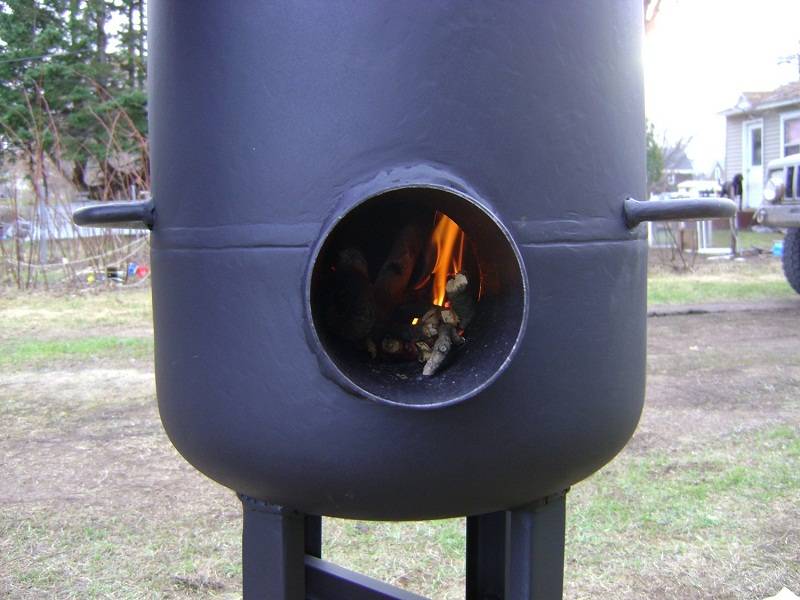
Rectangular stove - potbelly stove
The stove body is made in the form of a rectangular welded box made of metal with a thickness of 3 mm and more, inside which a horizontal partition made of a sheet of metal of the same thickness is equipped (welded in), dividing the internal space into two chambers: the upper, most part, the firebox and the lower part, the blower ... A grate window is cut into the horizontal partition, which can be equipped both in a removable and non-removable version. In a simpler, non-removable version, the grate is formed by metal rods, laid in parallel with a certain gap and welded across this window.The removable grate is made in the form of a metal frame according to the size of the grate window, to which, in parallel with the gap (the gap is the size of the thickness of the bar used), rods - grates are welded. In the front wall of the box, rectangular windows of the combustion chamber and ashtray are cut, on which the corresponding metal doors are hung.
The rectangular shape of this stove is convenient in that its upper wall can be additionally equipped with a cooking hole with a hob, and a metal box with sand can be installed on it, which will significantly increase the heat capacity of the stove and smooth out its heat transfer.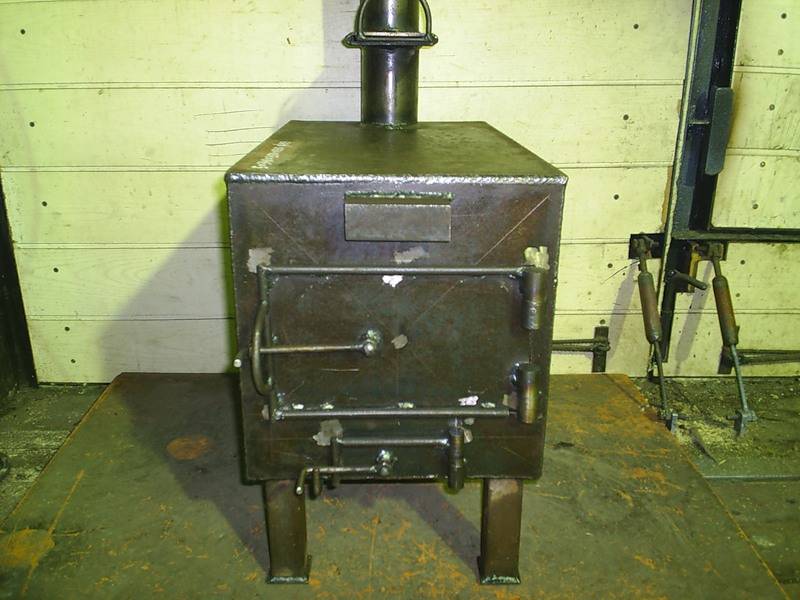
Oil-operated metal stove
The structures of metal portable stoves, which use used engine oil as a fuel, stand somewhat apart. Their field of application is rather narrow, and it is determined both by the emitted specific vapors, unacceptable in rooms where people are for a long time, and by the corresponding fuel, which in sufficient quantities for heating can only be in car garages, auto repair shops and industrial enterprises.
The design of this stove is relatively simple. It consists of a "pot" - a container for oil with a filler hole closed with a throttle plug for air passage.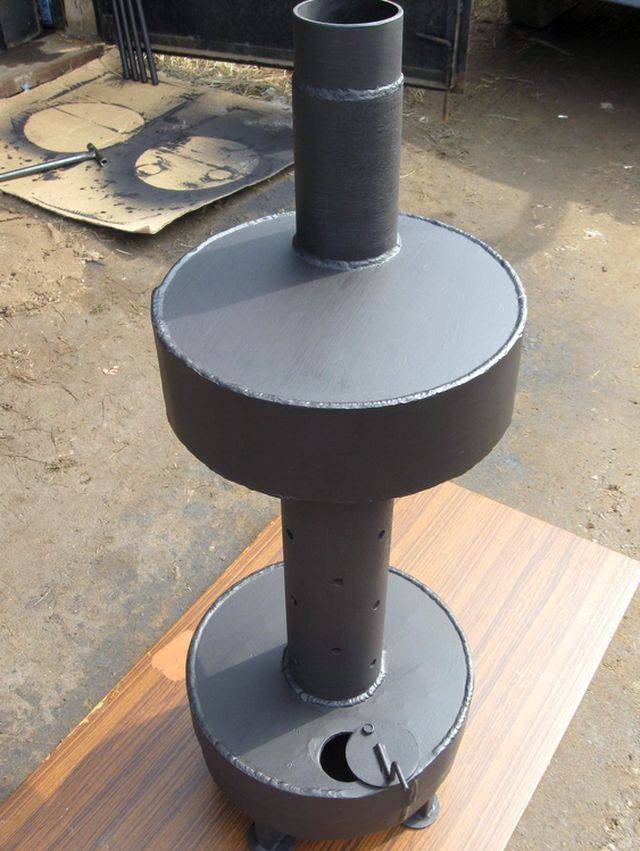
What are the stove stoves?
For the manufacture of the case, one of two metals is used:
- Cast iron.
- Steel.
Cast iron stove stoves on wood for a summer residence will have an impressive mass. Its heating takes a little longer than steel.
But inertia pays off when attenuation occurs. The steel walls are hot while the combustion process is in progress, and then cool down just as quickly. Cast iron, on the other hand, retains heat for some time after damping.
In addition, cast iron has a longer service life, such a stove will not burn out for a long time. But at the same time, it can be damaged, for example, by dropping or hitting with a heavy object - there is a possibility of cracks and the apparatus will become unusable.
Other differences in models. Potbelly stoves can be:
- With legs.
- Without legs, on a flat base.
The first ones look more elegant, but they are safer to use.
- rectangular;
- barrel-shaped.
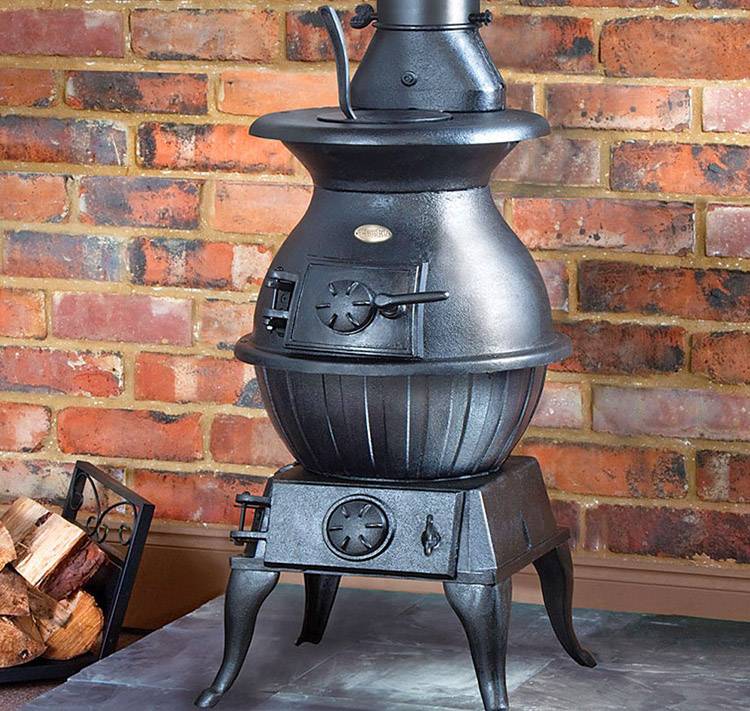
Barrel-shaped potbelly stove
The latter are most often done by hand, for example, from a piece of pipe.
How and with what to heat a stove-stove?
Fuel. Steel potbelly stoves are designed for wood heating. You can also use sawdust-based fuel briquettes, which are sold at construction malls. Furnaces designed for firing with coal are made of cast iron.
Modes of operation. Most ovens of this type can operate in one of two modes: intense combustion and maintaining temperature. For intensive combustion, after loading the wood and closing the oven door, open the ash drawer to ensure that the maximum amount of oxygen is supplied to the firebox. To put the stove in the mode of slow burning (maintaining the temperature), put the wood again and close the ash drawer. The slow burning time depends on the design of the furnace and can be up to 8 hours for models equipped with afterburners.
Draft adjustment is carried out by a gate damper: in case of excessive draft, the damper is partially closed.
Remember: you can use the stove in intensive combustion mode for no more than 2 hours a day!
ADVICE
To extend the life of the furnace, experts recommend intensively heating the furnace for 15-20 minutes after the slow combustion mode: this is necessary to remove the soot formed during slow combustion of the fuel.

Device and principle of operation
What is the difference between Burzhuyka Loginov and other metal stoves? The bottom line is the L-shaped blower. The ash-pan door is replaced with pipes welded perpendicularly. The end of the horizontal pipe is tightly welded, and the end of the vertical pipe is threaded for a plug. Holes are made on the thread - screwing the plug can reduce the air flow, thereby regulating the combustion process.

Loginov's original stove
It is important to make a plug with a slight backlash, so the expansion of the metal when heated will not cause problems. On the sides and back on the stiffeners, a screen is welded to increase efficiency
Without such screens, it is extremely uncomfortable near the stove - the temperature is too high and fraught with burns. The firebox door is also threaded. A 200mm pipe serves as an opening for the furnace, and a 220mm diameter plug with a handle is screwed onto this pipe.
More details about Loginov's stove can be seen in this video:
Modification
N. Pyankov's model is distinguished by the presence of an additional combustion chamber. Unlike more complex designs of slow combustion furnaces, Pyankov's stove is made even faster, according to the model proposed by Loginov. It is enough to weld steel sheets 140-160 mm long at different distances from the top to the rear and front walls of the furnace. The distance between the sheets should be 80mm. The grate is installed 80mm from the bottom. Pyankov transferred Loginov's firebox door to the upper part of the stove and began to use it as a hob.
It will not be difficult for a good craftsman to evaluate all the advantages and disadvantages of the two drawings. If you wish, you can make a new model of a potbelly stove using only these two developments, changing the rectangular shape to a round one.
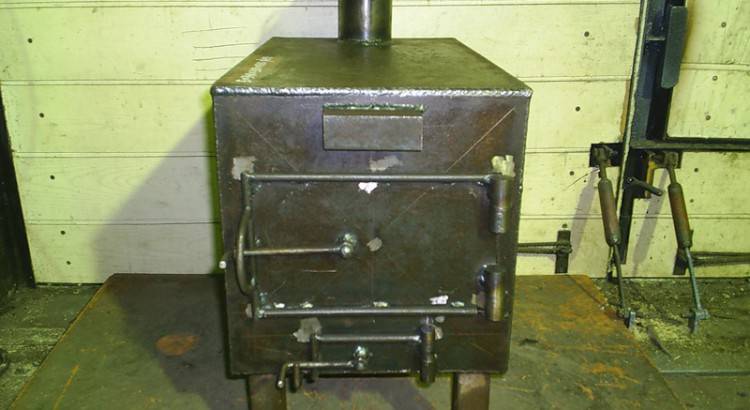
An example of a homemade design (in this photo, a modernized Pyankov furnace), but there is practically no difference in the manufacturing process.
Design
The old models of "burzhuekas" were not very diverse, the designers did not pay any attention to them. Usually, the owner of such a model himself came up with the appropriate design for it. He gave it a more attractive appearance and sought to increase its functionality.

Today, you can take advantage of modern options that can become an interior decoration. These include:
- art casting;
- colored glaze;
- overlays;
- heat-resistant paints.
Such models, in addition to the original external design, differ in their shape. They can successfully replace a fireplace in the house. "Potbelly stove" will be able to repeat its classic form.
How to make the right choice of "stove-stove"
To determine the required power of the product, an appropriate calculation is made. It is believed that 1 kW corresponds to 10 cubic meters. meters of room area. To use the stove only in the spring-summer season, its capacity may be slightly less than the calculated value.
The size of the stove depends on the dimensions of the firebox. And it affects the power of the entire structure. I must say that the size of the stove with the same volume of the firebox can be different. It is influenced by design features.
When choosing a model, always remember that the installation of the stove should be carried out away from various objects:
- from the side - 500 mm;
- behind - 500 mm;
- front - 1250 mm;
- top - 1200 mm.
Of course, the size of the firebox affects the length of the firewood.
Chimney parts are never sold with a stove. They are selected separately, since the configuration of the pipe depends on the construction of the house.
Fuel. Stoves made of metal are heated with wood. They can be replaced with fuel briquettes, the main of which is ordinary sawdust. Cast iron stoves can be fired with coal.
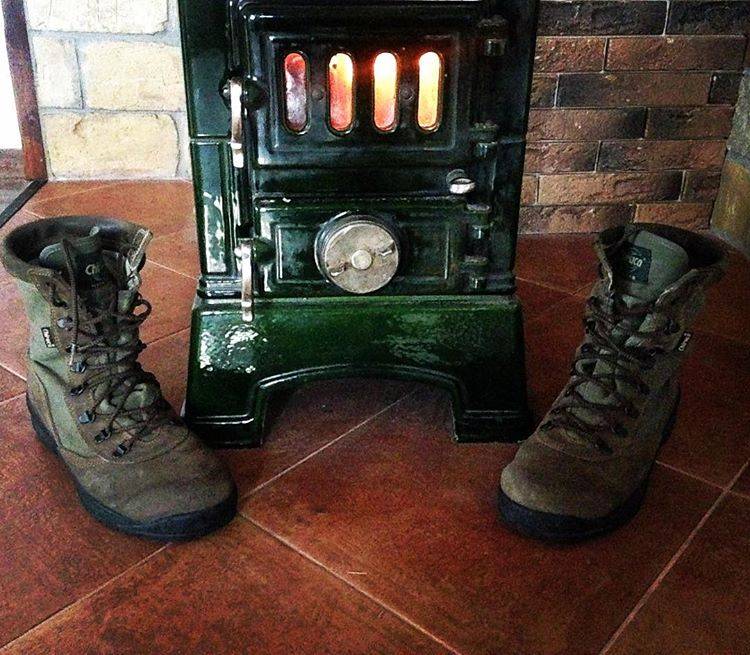
Working modes. Almost all types of such furnaces are capable of operating normally in several modes:
- intense burning;
- maintaining the desired temperature.
In order to carry out intensive combustion, it is necessary to open the ash drawer. A large amount of oxygen will begin to flow into the furnace.
To create a slow burning, add fuel and close the box. Products equipped with afterburners can maintain the desired temperature for 8 hours.
The traction force is regulated by a special damper - a gate. If there is a strong draft, the damper is closed slightly.
The stove can sustain intense combustion for only two hours a day.
A little advice. To increase the life of the stove, experienced craftsmen advise, after slow burning, to strongly heat the stove. This operation should be performed for about 15-20 minutes. At this time, the removal of soot occurs, which appears when the fuel burns too slowly.
